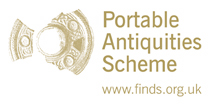File:Roman , Bracelet (FindID 808654).jpg

Original file (2,918 × 1,202 pixels, file size: 637 KB, MIME type: image/jpeg)
Captions
Captions
Summary
[edit]| Roman : Bracelet | |||
|---|---|---|---|
| Photographer |
York Museums Trust, Rebecca Griffiths, 2016-10-24 14:07:42 |
||
| Title |
Roman : Bracelet |
||
| Description |
English: A fragment of a probable glass bracelet of Roman date, c.AD 100 - 400. All that remains is a circular sectioned strip of plain blue glass, broken at both ends. The fragment is likely to be the central decorative strip which would have been fitted into a recess on the bracelet proper.
The bracelet is 32.3mm long, 3.5mm in diameter and weighs 0.8g. Bracelets and bangles of a variety of materials, including metal, jet and shale are a particularly common find on Romano-British sites. Johns (1996, 121) suggests coloured glass bangles were at the height of fashion in the earlier centuries of Roman occupation in Britain. Additionally H. E. Kilbride-Jones created a detailed typology of early Roman glass bangles in 1938. To create them, molten glass would be rolled out on a cool surface, such as marble, and the main bracelet would have to maintain a temperature which would allow the second piece, the darker strip, to be added without causing the glass to shatter. Despite this, such bracelets were easy and fast to manufacture. Their use remains unclear and while it is possible they were worn as arm or leg ornaments, they may also have had a more specialised use not currently understood. Currently 13 glass bangle fragments are recorded on the PAS database. Six of these are from the East Riding of Yorkshire (YORYM-620A34, YORYM-B985BA, YORYM-6EC79C, YORYM-7325B6, FAKL-C8D895, YORYM160), two from North Yorkshire (SWYOR-2A4D36 and YORYM-6D12A7) two from Lincolnshire (NCL-A8FD74 and LIN-E2A761) and one from each of the following counties: Durham (NCL-8B5644), Doncaster (SWYOR-65B384), and North Lincolnshire (NLM-9E8743). <a href="https://finds.org.uk/database/search/results/objecttype/BRACELET/broadperiod/ROMAN/material/18">https://finds.org.uk/database/search/results/objecttype/BRACELET/broadperiod/ROMAN/material/18</a>. |
||
| Depicted place | (County of findspot) East Riding of Yorkshire | ||
| Date | between 100 and 400 | ||
| Accession number |
FindID: 808654 Old ref: YORYM-BA9942 Filename: RoD0455.jpg |
||
| Credit line |
|
||
| Source |
https://finds.org.uk/database/ajax/download/id/587482 Catalog: https://finds.org.uk/database/images/image/id/587482/recordtype/artefacts Artefact: https://finds.org.uk/database/artefacts/record/id/808654 |
||
| Permission (Reusing this file) |
Attribution License version 2.0 (verified 13 November 2020) | ||
| Object location | 53° 44′ 57.48″ N, 0° 34′ 33.8″ W | View this and other nearby images on: OpenStreetMap |
|---|
Licensing
[edit]- You are free:
- to share – to copy, distribute and transmit the work
- to remix – to adapt the work
- Under the following conditions:
- attribution – You must give appropriate credit, provide a link to the license, and indicate if changes were made. You may do so in any reasonable manner, but not in any way that suggests the licensor endorses you or your use.
File history
Click on a date/time to view the file as it appeared at that time.
| Date/Time | Thumbnail | Dimensions | User | Comment | |
|---|---|---|---|---|---|
| current | 18:31, 20 December 2018 | 2,918 × 1,202 (637 KB) | Fæ (talk | contribs) | Portable Antiquities Scheme, YORYM, FindID: 808654, roman, page 3001, batch count 9832 |
You cannot overwrite this file.
File usage on Commons
The following page uses this file:
Metadata
This file contains additional information such as Exif metadata which may have been added by the digital camera, scanner, or software program used to create or digitize it. If the file has been modified from its original state, some details such as the timestamp may not fully reflect those of the original file. The timestamp is only as accurate as the clock in the camera, and it may be completely wrong.
| Orientation | Normal |
|---|---|
| Horizontal resolution | 600 dpi |
| Vertical resolution | 600 dpi |
| Software used | Adobe Photoshop Elements 7.0 Windows |
| File change date and time | 10:31, 24 October 2016 |
| Color space | sRGB |
| Image width | 2,918 px |
| Image height | 1,202 px |
| Date and time of digitizing | 11:31, 24 October 2016 |
| Date metadata was last modified | 11:31, 24 October 2016 |
| IIM version | 26,360 |
